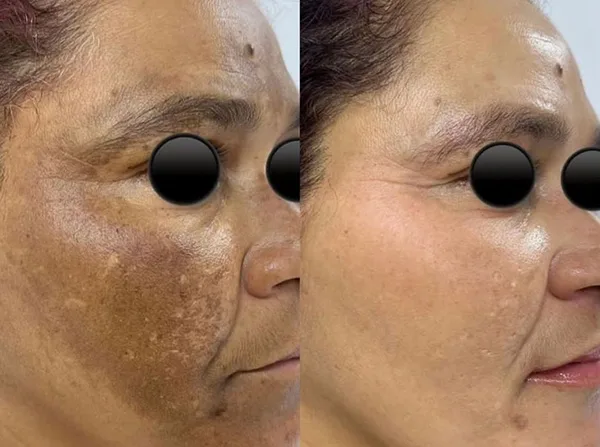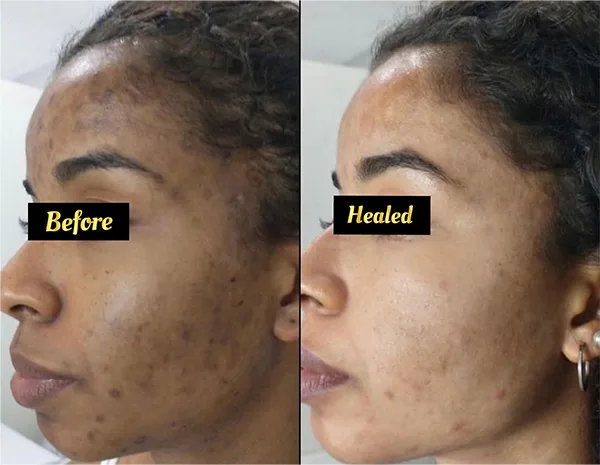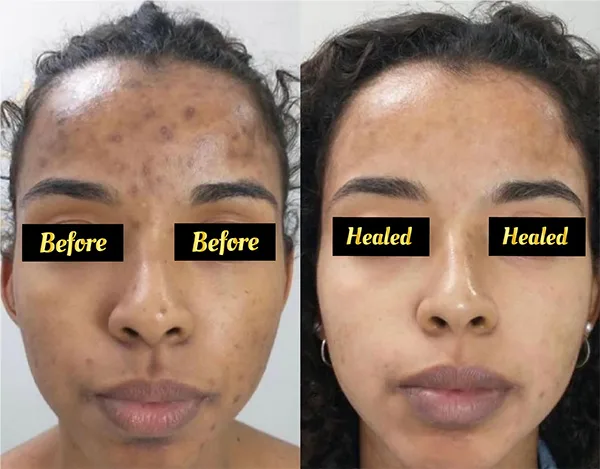Melasma Laser Treatment in Nairobi, Kenya
Melasma laser treatment is a common procedure used to address the pigmentation disorder known as melasma. Melasma causes dark, discolored patches on the skin, often on the face, particularly the cheeks, forehead, upper lip, and chin. While there are various treatment options available for melasma, including topical creams, chemical peels, and oral medications, laser therapy has gained popularity due to its effectiveness in targeting deeper layers of the skin where melasma occurs.
Melasma is a common skin condition characterized by brown or gray-brown patches on the face, particularly on the cheeks, forehead, nose, and chin. It typically appears on both sides of the face and is more common in women than in men. The exact cause of melasma is unknown, but it is believed to be related to hormonal changes, sun exposure, and genetics. Melasma is not harmful, but it can be a cosmetic concern for many people. Treatment options include topical medications, chemical peels, and laser therapy, but the condition may recur even after successful treatment. Sun protection is also important in preventing melasma from worsening or reoccurring.
Laser treatments for melasma work by emitting concentrated beams of light that target the melanin-producing cells (melanocytes) in the skin. The heat from the laser breaks down the excess melanin, leading to a reduction in pigmentation. There are different types of lasers used for melasma treatment, including fractional lasers, Q-switched lasers, and intense pulsed light (IPL) devices.
It’s important to note that melasma can be challenging to treat, and results can vary from person to person. Multiple sessions may be required to achieve desired outcomes, and maintenance treatments may be necessary to prevent recurrence. Additionally, sun protection is crucial before and after laser treatments, as exposure to UV radiation can exacerbate melasma.
Before undergoing any laser treatment, it’s essential to Consult with one of our qualified professional who can assess your skin condition and recommend the most appropriate treatment plan based on your individual needs and medical history. They can also discuss potential risks, benefits, and expected outcomes of melasma laser treatment.
Types of Melasma
Melasma is a common skin condition characterized by patches of dark, discolored skin, typically on sun-exposed areas of the face. There are three main types of melasma based on their distribution and etiology:
- Epidermal Melasma: This type of melasma affects the top layer of the skin (epidermis) and appears as brownish patches with well-defined borders. Epidermal melasma often responds well to treatment and may fade with topical creams, chemical peels, or laser therapy.
- Dermal Melasma: Dermal melasma affects the deeper layers of the skin (dermis) and appears as bluish-gray patches with less defined borders. This type of melasma can be more challenging to treat and may require a combination of treatments, including laser therapy and oral medications.
- Mixed Melasma: Mixed melasma involves a combination of both epidermal and dermal components, with patches appearing as a mix of brownish and bluish-gray discoloration. Mixed melasma often requires a comprehensive treatment approach targeting both the epidermal and dermal layers of the skin.
Additionally, melasma can be classified based on its distribution and underlying causes:
- Centrofacial Melasma: This is the most common type of melasma and typically affects the central areas of the face, including the cheeks, forehead, nose, upper lip, and chin. Centrofacial melasma is often associated with hormonal changes, sun exposure, and genetic factors.
- Malar Melasma: Malar melasma specifically affects the cheeks and is characterized by symmetrical patches of pigmentation on both sides of the face. This type of melasma is commonly associated with sun exposure and may occur in individuals with darker skin tones.
- Lateral Cheek Melasma: Lateral cheek melasma involves pigmentation on the sides of the cheeks, extending towards the temples. This type of melasma may be more prevalent in individuals with olive or darker skin tones and can be challenging to treat.
- Mandibular Melasma: Mandibular melasma affects the jawline and lower face, often extending from the corners of the mouth to the jawline. This type of melasma may be influenced by hormonal changes, sun exposure, and genetic predisposition.
Understanding the type and distribution of melasma is essential for developing an effective treatment plan tailored to each individual’s needs and skin characteristics. At Rebel Inks Tattoos, Tattoo Removal, and Body Piercings Parlour our professionals can provide a comprehensive evaluation and recommend the most appropriate treatment approach based on the specific type of melasma and underlying factors.
Melasma Laser Treatment Procedure
The melasma laser treatment procedure typically involves several steps, and it’s important to consult with a professional who specializes in laser therapy for melasma to determine the best approach for your specific condition. Here’s an overview of what you might expect during a melasma laser treatment session:
- Consultation: Before undergoing any laser treatment, you’ll have a consultation with one of our professionals who specializes in Melasma Laser Treatementr. During this consultation, they will assess your skin, discuss your medical history, and determine if you’re a suitable candidate for laser therapy. They will also explain the procedure, discuss expected outcomes, and address any questions or concerns you may have.
- Preparation: Prior to the laser treatment, your skin will be cleansed to remove any makeup, dirt, or oil. You may also be given protective eyewear to shield your eyes from the laser light.
- Numbing cream (optional): Depending on the type of laser used and your pain tolerance, our specialist may apply a topical numbing cream to the treatment area to minimize discomfort during the procedure.
- Laser treatment: Once your skin is prepared, the laser treatment will begin. The specific type of laser used will depend on factors such as the depth of the melasma and your skin type. Common types of lasers for melasma treatment include fractional lasers, Q-switched lasers, and intense pulsed light (IPL) devices.
a. The laser emits concentrated beams of light that target the melanin-producing cells (melanocytes) in the skin, breaking down excess melanin and reducing pigmentation.
b. The laser energy is delivered in pulses, and your healthcare provider will carefully move the laser device over the treatment area, ensuring even coverage.
c. You may feel a mild sensation of heat or discomfort during the procedure, but any discomfort is usually well-tolerated, especially with the use of numbing cream or cooling techniques. - Post-treatment care: After the laser treatment, your skin may appear red or slightly swollen, similar to a mild sunburn. Our specialist may apply a soothing cream or gel to help alleviate any discomfort and protect the skin. You’ll also receive instructions on how to care for your skin post-treatment, including avoiding sun exposure, using gentle skincare products, and moisturizing regularly.
- Follow-up appointments: Depending on the severity of your melasma and the type of laser used, you may require multiple treatment sessions spaced several weeks apart to achieve optimal results. Your healthcare provider will schedule follow-up appointments to monitor your progress and adjust the treatment plan as needed.
It’s important to follow all post-treatment instructions provided by our professional specialists and avoid sun exposure as much as possible, as UV radiation can exacerbate melasma. With proper care and adherence to your treatment plan, you can expect to see gradual improvement in your melasma over time.
Types of Lasers used in Treatment of Melasma
In the treatment of melasma, various types of lasers can be used, each with its own mechanism of action and effectiveness. Here are some of the common types of lasers used:
Q-switched Nd:YAG (Neodymium-doped yttrium aluminum garnet) laser
The Q-switched Nd:YAG (Neodymium-doped yttrium aluminum garnet) laser is a type of laser commonly used in dermatology for various skin conditions, including the treatment of pigmentation disorders like melasma.
This laser emits light at a specific wavelength that targets melanin in the skin without causing significant damage to surrounding tissues. It is effective for treating superficial pigmentation
Here’s a closer look at how it works and its application in melasma treatment:
Mechanism of Action:
The Q-switched Nd:YAG laser emits light at a specific wavelength (typically 1064 nanometers) that is highly absorbed by melanin, the pigment responsible for darkening the skin in conditions like melasma. This laser operates in short pulses of high energy, which are delivered in nanoseconds (billionths of a second). The rapid delivery of energy allows for selective targeting of melanin-containing cells while minimizing damage to surrounding tissues.
Application in Melasma Treatment:
- The Q-switched Nd:YAG laser is effective for treating superficial pigmentation, including melasma patches on the skin.
- During treatment, the laser energy is absorbed by the excess melanin in the skin, causing it to fragment into smaller particles.
- Over time, the fragmented melanin is cleared by the body’s natural processes, leading to a lightening of the melasma patches and an improvement in overall skin tone.
Benefits:
The Q-switched Nd:YAG laser offers several advantages for melasma treatment, including precise targeting of pigmented lesions, minimal downtime, and a low risk of adverse effects when performed by a skilled practitioner.
It can be used safely on various skin types, including darker skin tones, with minimal risk of hypopigmentation (lightening of the skin).
Considerations:
- Multiple treatment sessions may be required to achieve optimal results, depending on the severity of the melasma and individual response to treatment.
- Multiple treatment sessions may be required to achieve optimal results, depending on the severity of the melasma and individual response to treatment.
Fractional lasers
Fractional lasers work by creating microscopic columns of thermal damage in the skin, which stimulates collagen production and promotes the growth of new, evenly pigmented skin cells. Fractional lasers can penetrate deeper layers of the skin and are effective for treating both superficial and deep melasma. Examples include fractional CO2 lasers and fractional erbium lasers.
Mechanism of Action:
Fractional lasers work by delivering controlled beams of laser energy to the skin, creating microscopic columns of thermal damage known as microthermal zones (MTZs). These MTZs stimulate the body’s natural healing response, promoting the production of new collagen and the growth of fresh, evenly pigmented skin cells. Fractional lasers can penetrate the skin at varying depths, depending on the specific wavelength and settings used, allowing for precise targeting of pigmentation and other skin concerns.
Application in Melasma Treatment:
Fractional lasers can be effective for treating both superficial and deep pigmentation associated with melasma. The controlled heat generated by fractional laser treatment helps to break down excess melanin in the skin, leading to a reduction in pigmentation and an improvement in overall skin tone. Fractional lasers can also help to improve skin texture, reduce the appearance of fine lines and wrinkles, and promote overall skin rejuvenation.
Types of Fractional Lasers:
There are several types of fractional lasers available, including fractional CO2 lasers, fractional erbium lasers, and fractional non-ablative lasers.
- Fractional CO2 lasers deliver high-energy pulses of laser light to the skin, causing controlled damage to the epidermis and dermis. They are effective for treating both pigmentation and skin texture concerns but may require more downtime due to the ablative nature of the treatment.
- Fractional erbium lasers operate at a wavelength that is highly absorbed by water in the skin, allowing for precise targeting of pigmentation while minimizing damage to surrounding tissues. They are often preferred for patients with darker skin tones due to their reduced risk of post-inflammatory hyperpigmentation.
- Fractional non-ablative lasers deliver laser energy to the skin without removing the outer layer, making them a gentler option with minimal downtime. While they may be less effective for deep pigmentation, they can still provide noticeable improvements in melasma and overall skin quality.
Benefits and Considerations:
Fractional laser treatment for melasma offers several benefits, including precise targeting of pigmentation, customizable treatment parameters, and minimal downtime compared to traditional ablative lasers. However, multiple treatment sessions may be required to achieve optimal results, and results may vary depending on factors such as the severity of the melasma and individual skin response. It’s essential to protect the skin from sun exposure before and after fractional laser treatment, as UV radiation can exacerbate melasma and interfere with the healing process.
Picosecond lasers:
Picosecond lasers are advanced laser devices that emit ultra-short pulses of laser energy in picoseconds (trillionths of a second). These lasers have gained popularity in dermatology due to their ability to effectively target pigment particles in the skin with minimal heat damage to surrounding tissues. Picosecond lasers are particularly useful for treating stubborn or resistant melasma.
Here’s a closer look at picosecond lasers and their application in treating melasma:
Mechanism of Action:
Picosecond lasers deliver extremely short bursts of laser energy, which are absorbed by pigment particles in the skin, including melanin responsible for melasma. The rapid pulses of energy generate a photomechanical effect, causing the targeted pigment to fragment into smaller particles without significant heat buildup. This fragmentation process helps to break down excess melanin in the skin, leading to a reduction in pigmentation and an improvement in overall skin tone.
Application in Melasma Treatment:
Picosecond lasers are particularly useful for treating stubborn or resistant pigmentation disorders like melasma. The ultra-short pulses of laser energy allow for precise targeting of pigment particles, even in deeper layers of the skin, while minimizing damage to surrounding tissues. Picosecond lasers can be effective for both superficial and deep melasma, providing noticeable improvements in pigmentation and overall skin texture.


Benefits:
Picosecond lasers offer several advantages for melasma treatment, including high efficacy, minimal discomfort during treatment, and shorter treatment sessions compared to traditional lasers. These lasers can be used safely on various skin types, including darker skin tones, with minimal risk of hypopigmentation (lightening of the skin). Picosecond lasers may also stimulate collagen production and promote overall skin rejuvenation, leading to additional benefits beyond pigmentation reduction.
Considerations:
While picosecond lasers are generally well-tolerated, some individuals may experience mild redness, swelling, or temporary darkening of the treated area following treatment. These side effects typically resolve within a few days to a week. Multiple treatment sessions may be required to achieve optimal results, depending on the severity of the melasma and individual response to treatment. It’s essential to protect the skin from sun exposure before and after picosecond laser treatment, as UV radiation can exacerbate melasma and interfere with the healing process.
Intense pulsed light (IPL) therapy:
Intense Pulsed Light (IPL) therapy, although technically not a laser, is a popular treatment modality for various skin conditions, including melasma. IPL devices emit broad-spectrum light that targets melanin and hemoglobin in the skin. IPL therapy can help reduce pigmentation and improve overall skin tone. While IPL is less specific than lasers, it can be effective for treating melasma, especially when combined with other treatments.
Here’s a breakdown of how IPL works and its application in melasma treatment:
Mechanism of Action:
IPL devices emit a broad spectrum of light wavelengths that target melanin (pigment) and hemoglobin (blood vessels) in the skin. The light energy is absorbed by the melanin in the melasma patches, causing the pigment to fragment and eventually be absorbed by the body’s natural processes. IPL therapy can also stimulate collagen production, leading to improved skin texture and overall skin rejuvenation.
Application in Melasma Treatment:
IPL therapy can be effective for treating melasma, particularly in patients with light to moderate pigmentation and a preference for non-laser treatments. The broad spectrum of light emitted by IPL devices allows for customizable treatment parameters, making it possible to target different types and depths of pigmentation associated with melasma. IPL can provide gradual improvement in melasma over a series of treatment sessions, with minimal downtime compared to some laser treatments.
Benefits:
IPL therapy offers several advantages for melasma treatment, including the ability to target multiple skin concerns simultaneously, such as pigmentation, redness, and uneven skin tone. The treatment is generally well-tolerated, with minimal discomfort and downtime, making it suitable for patients with busy lifestyles. IPL devices are versatile and can be adjusted to accommodate different skin types and pigmentation levels, allowing for personalized treatment plans.
Considerations:
While IPL therapy can be effective for treating melasma, results may vary depending on factors such as the severity of the pigmentation and individual skin response. Multiple treatment sessions are typically required to achieve optimal results, spaced several weeks apart to allow for skin healing and collagen remodeling. It’s essential to protect the skin from sun exposure before and after IPL treatment, as UV radiation can exacerbate melasma and interfere with the healing process.
Fractional photothermolysis:
Fractional photothermolysis is an advanced laser treatment technique used to address various skin concerns. This approach combines the principles of fractional lasers with photothermolysis, using controlled heat to target melanin in the skin while minimizing damage to surrounding tissues. Fractional photothermolysis can be an effective option for treating melasma, especially when other treatments have not produced satisfactory results.
Here’s a detailed explanation of what it entails and how it can be applied to treat melasma:
Mechanism of Action:
Fractional photothermolysis combines the principles of traditional fractional lasers with photothermolysis, a process that uses light and heat to target specific structures in the skin. The laser delivers controlled pulses of energy into the skin, creating microscopic columns of thermal damage known as microthermal zones (MTZs). These MTZs stimulate the body’s natural healing response, promoting the production of new collagen and the growth of fresh, evenly pigmented skin cells. Fractional photothermolysis allows for precise targeting of melanin in the skin, leading to a reduction in pigmentation associated with melasma.
Application in Melasma Treatment:
Fractional photothermolysis can be effective for treating both superficial and deep pigmentation associated with melasma. The controlled heat generated by the laser helps to break down excess melanin in the skin, leading to a reduction in pigmentation and an improvement in overall skin tone. Fractional photothermolysis can also improve skin texture, reduce the appearance of fine lines and wrinkles, and promote overall skin rejuvenation.
Benefits:
Fractional photothermolysis offers several advantages for melasma treatment, including precise targeting of pigmentation, customizable treatment parameters, and minimal downtime compared to traditional ablative lasers. The treatment can be tailored to address individual skin concerns and pigmentation levels, allowing for personalized treatment plans. Fractional photothermolysis can be used safely on various skin types, including darker skin tones, with minimal risk of hypopigmentation (lightening of the skin).
Considerations:
While fractional photothermolysis is generally well-tolerated, some individuals may experience mild redness, swelling, or temporary darkening of the treated area following treatment. These side effects typically resolve within a few days to a week. Multiple treatment sessions may be required to achieve optimal results, depending on the severity of the melasma and individual response to treatment. It’s essential to protect the skin from sun exposure before and after fractional photothermolysis treatment, as UV radiation can exacerbate melasma and interfere with the healing process.
It’s important to note that the choice of laser treatment depends on factors such as the type and severity of melasma, skin type, and individual response to treatment. Additionally, multiple treatment sessions may be required to achieve optimal results, and maintenance treatments may be necessary to prevent melasma recurrence.
There are several other common treatments for melasma, including:
- Topical bleaching agents: These are creams or gels that contain ingredients such as hydroquinone, azelaic acid, kojic acid, and tretinoin. These ingredients help to lighten the dark patches of melasma over time.
- Chemical peels: This treatment involves the application of a chemical solution to the affected area, which causes the top layer of skin to peel off. This can help to reduce the appearance of melasma.
- Microdermabrasion: This treatment uses a special device to gently exfoliate the top layer of skin, helping to reduce the appearance of melasma.
- Sun protection: Protecting your skin from the sun is key to preventing melasma from getting worse. Wearing sunscreen with an SPF of at least 30 and avoiding direct sunlight during peak hours can help to protect your skin.
It is important to note that melasma can be a difficult condition to treat, and results may vary depending on the severity of the condition and individual factors such as skin type and genetics. It is always best to Consult with Us in advance to get advice on the best treatment options for you.
Learn More about Melasma Treatment →
Schedule Appointment
Melasma Laser Treatment Aftercare
After undergoing melasma laser treatment, proper aftercare is essential to optimize results, minimize potential side effects, and promote skin healing. Here are some general guidelines for melasma laser treatment aftercare:
- Protect Your Skin from Sun Exposure: Sun protection is crucial after melasma laser treatment as UV radiation can trigger melasma and worsen pigmentation. Wear broad-spectrum sunscreen with SPF 30 or higher daily, even on cloudy days. Reapply sunscreen every two hours when outdoors, and wear protective clothing, such as hats and sunglasses, to shield your skin from the sun.
- Avoid Heat and Excessive Sweating: For the first few days after treatment, avoid activities that can increase skin temperature and sweating, as this may exacerbate inflammation and prolong recovery. Avoid hot showers, saunas, steam rooms, and intense workouts until your skin has fully healed.
- Keep Your Skin Moisturized: Apply a gentle, non-comedogenic moisturizer to keep your skin hydrated and promote healing. Avoid products containing harsh ingredients, fragrances, or exfoliants that may irritate your skin.
- Use Gentle Skincare Products: Choose skincare products specifically formulated for sensitive or post-procedure skin. Avoid using harsh cleansers, scrubs, or abrasive skincare products that can disrupt the skin barrier and delay healing.
- Avoid Picking or Scrubbing Your Skin: Resist the urge to pick, scratch, or scrub your skin after melasma laser treatment, as this can increase the risk of infection, scarring, and hyperpigmentation. Let your skin heal naturally, and avoid any aggressive skincare treatments until cleared by your healthcare provider.
- Stay Hydrated: Drink plenty of water to keep your skin hydrated from the inside out. Hydration is essential for skin healing and overall skin health.
- Follow Post-Treatment Instructions: Your healthcare provider will provide you with specific post-treatment instructions tailored to your individual needs and the type of laser used. Follow these instructions carefully to ensure optimal results and minimize the risk of complications.
- Attend Follow-Up Appointments: Attend all scheduled follow-up appointments with your healthcare provider to monitor your skin’s response to treatment, address any concerns or questions you may have, and adjust your treatment plan as needed.
- Be Patient: It may take several weeks to see the full results of melasma laser treatment. Be patient and consistent with your aftercare routine, and trust the process as your skin heals and pigmentation gradually improves.
If you experience any unusual or severe side effects after melasma laser treatment, such as excessive pain, swelling, blistering, or prolonged redness, Contact Us immediately for further evaluation and guidance.
Benefits of Melasma Laser Treatment
Melasma laser treatment offers several benefits for individuals dealing with this pigmentation disorder. Here are some of the key advantages:
- Targeted Pigmentation Reduction: Melasma laser treatment precisely targets excess melanin in the skin, leading to a reduction in pigmentation and lightening of melasma patches. Laser energy penetrates the skin to break down melanin particles, resulting in a more even skin tone.
- Customizable Treatment: Various types of lasers can be used for melasma treatment, allowing for customization based on factors such as skin type, severity of melasma, and individual response to treatment. This personalized approach helps optimize outcomes and minimize the risk of adverse effects.
- Stimulates Collagen Production: Certain types of lasers used for melasma treatment, such as fractional lasers and picosecond lasers, stimulate collagen production in the skin. This collagen remodeling helps improve skin texture, smooth fine lines and wrinkles, and promote overall skin rejuvenation.
- Minimal Downtime: Many melasma laser treatments require minimal downtime, allowing individuals to resume their normal activities shortly after treatment. While some redness or swelling may occur temporarily, it typically resolves within a few days to a week.
- Long-lasting Results: Melasma laser treatment can provide long-lasting results when combined with proper sun protection and skincare maintenance. Although melasma may not be completely cured, laser therapy can significantly reduce pigmentation and prevent its recurrence with ongoing care.
- Safe for Various Skin Types: Laser technology has advanced significantly in recent years, making melasma laser treatment safe and effective for individuals with various skin types, including darker skin tones. Qualified healthcare providers can adjust treatment parameters to minimize the risk of complications and achieve optimal results for each patient.
- Improves Self-confidence: Melasma laser treatment can have a positive impact on a person’s self-esteem and confidence by reducing the appearance of pigmentation and improving overall skin appearance. Clearer, more even skin tone can enhance one’s sense of well-being and quality of life.
It’s important to note that while melasma laser treatment offers many benefits, results may vary depending on factors such as the severity of melasma, individual skin response, and adherence to post-treatment care. At Rebel Inks Tattoos, Tattoo Removal, and Body Piercings Parlour we have qualified professionals who can help determine the most appropriate treatment plan based on your specific needs and goals.
Things to Do Before going for a Melasma Laser Treatment Procedure
Before going for a melasma laser treatment procedure, here are some things you may want to consider:
- Consult with a dermatologist: Before undergoing any cosmetic procedure, it’s always a good idea to consult with a qualified dermatologist who can assess your skin condition, and determine whether laser treatment is the best option for your particular case.
- Avoid sun exposure: Avoiding sun exposure is important as sun damage can cause the melasma to return. You may want to avoid direct sunlight for a few days before the procedure.
- Avoid tanning: Avoid any tanning lotions, sprays, or creams at least two weeks before the procedure. This can affect the results of the treatment.
- Avoid certain medications: Certain medications such as blood thinners, aspirin, or ibuprofen may increase your risk of bleeding during the procedure. Make sure to tell your doctor about any medication you are taking before the procedure.
- Follow pre-procedure instructions: Your doctor may provide specific instructions on what to do before the procedure, such as avoiding alcohol or smoking, or taking any medication.
- Plan for recovery time: Laser treatment for melasma can take a few days to a few weeks to heal, depending on the intensity of the treatment. Make sure you have enough time to rest and recover after the procedure.
- Follow post-procedure instructions: Your doctor will give you specific instructions on how to care for your skin after the procedure. This may include avoiding direct sunlight, applying certain creams or ointments, and avoiding certain activities. Make sure you follow these instructions to ensure the best possible outcome.
Possible side effects of Melasma Laser Treatment
While melasma laser treatment can be effective in reducing pigmentation and improving skin tone, it’s essential to be aware of potential side effects that may occur, especially when not properly administered or cared for. Here are some possible side effects of melasma laser treatment:
- Redness and Swelling: It’s common to experience temporary redness and swelling in the treated area immediately after melasma laser treatment. This is a normal inflammatory response to the laser energy and typically resolves within a few hours to a few days.
- Increased Sensitivity: Your skin may become more sensitive to touch, heat, or sunlight following laser treatment. This heightened sensitivity usually subsides within a few days but may persist longer in some cases.
- Hyperpigmentation: In some instances, melasma laser treatment may cause temporary or permanent hyperpigmentation, leading to darkening of the treated area. This can occur if the laser energy stimulates melanin production or if the skin is exposed to sun without adequate protection during the healing process.
- Hypopigmentation: Conversely, hypopigmentation, or lightening of the skin, may occur as a result of melasma laser treatment, particularly in individuals with darker skin tones. This side effect is more common with certain types of lasers and may be temporary or permanent.
- Blistering and Crusting: In rare cases, blistering and crusting may occur following melasma laser treatment, especially if the laser energy is too intense or if the treated area is not properly cared for post-treatment. This usually resolves on its own but may require additional treatment or intervention.
- Scarring: While uncommon, scarring may occur as a result of melasma laser treatment, particularly with ablative lasers or in individuals prone to keloid or hypertrophic scarring. Proper wound care and adherence to post-treatment instructions can help minimize the risk of scarring.
- Reactivation of Melasma: In some cases, melasma may reappear or worsen following laser treatment, especially if sun exposure is not adequately avoided or if hormonal factors are not addressed. Maintenance treatments and sun protection are crucial for preventing melasma recurrence.
Testimonials
OUR LOCATION
Areas We Serve
NAIROBI
KIAMBU
KAJIADO
MACHAKOS






































































